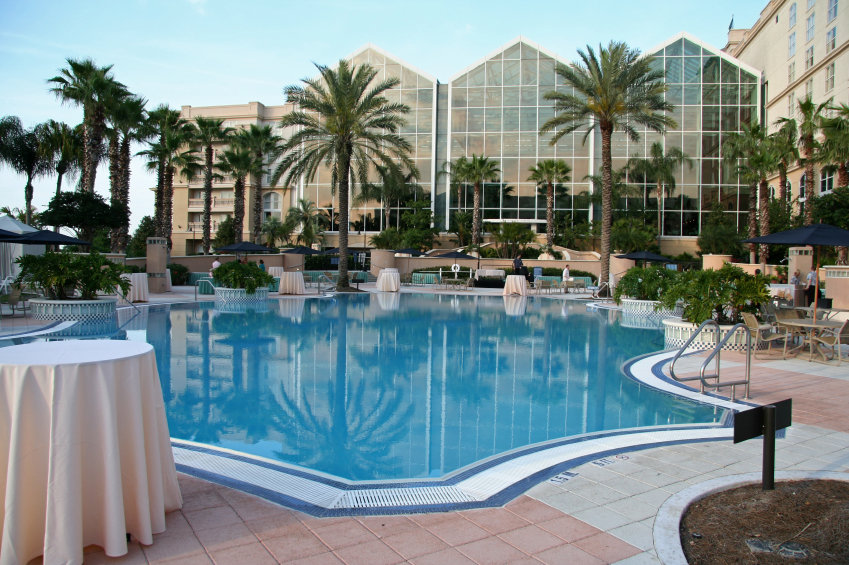Security: Lighting and Landscaping

By Michael Khairallah, Senior Security Systems Consultant, Security Design Solutions
Guest safety is always paramount in the design or renovation of hotels but often that objective is unintentionally defeated by other design considerations. Hotels want an attractive environment for their guests and generally provide lighting and a landscaping plan that enhances the architectural nature of the building and add to the guest experience. The unintended consequence of focusing on these design elements without security considerations can provide unwanted access to the building, concealment for wrongdoers and reduce guest safety.
Lighting
The elements of private security are to detect, deter, delay and respond to unwanted activity in a protected facility, lighting provides deterrence to criminal activity. In most hotels, the interior lighting plan is generally more than adequate for most safety considerations however; the areas around the property, especially parking lots often do not receive adequate attention.
Most of the criminal acts at shopping centers, strip malls and business offices occur in the parking lot. Lawsuits often revolve around lack of sufficient lighting, surveillance and response. To improve security, deter crime, reduce potential liability and create a safer environment ample lighting in parking lot areas is essential.
Security lighting is used to increase awareness and visual range during periods of darkness or by increased illumination of an area where natural light does not reach or is insufficient. Parking lots are unique and each presents its own problems based on layout, terrain and atmospheric conditions. The goal of exterior lighting is to provide a specified level of light throughout the area and good visibility for guests and employees with minimum glare.
The most severe problem is illuminating the small narrow "corridors" formed by adjacent parked cars. In order to get light into these areas, arrange lighting so that any point in the parking lot has illumination from at least 2 and preferably 4 lighting locations. The source should be with pole lights mounted at a minimum height of 20 ft. The minimum recommended illumination level for parking lots is 1 foot-candle (average maintained horizontal to the surface) for self-parking lots. That minimum level can be increased to 5 foot-candles for aesthetic or commercial reasons such as advertisement of hotel amenities where necessary. Special attention should also be give to entrances, exits, loading zones and access lanes of parking areas. The acceptable light level “rule of thumb” at parking lot access to public streets should not be less than twice the illumination of the connecting street. Lighting poles should be mounted along the parking barriers and outside boundaries.
Lighting should be positioned to increase visibility and the parking layout should be perpendicular to the line of sight from the building exit. This is to reduce the criminal value of hiding between cars waiting for potential victims. Walking corridors between cars at strategic locations also concentrates foot traffic and increases natural surveillance.
Ensure that there is adequate lighting in areas where closed circuit television (CCTV) cameras are used. Adequate lighting in the camera view areas may change the type of camera required which would reduce the cost of the equipment and will provide more usable images for investigative and detection purposes. Adequate lighting of a camera view will also provide enhanced response for security personnel. When light levels are high, cameras can discern color, a major clue in identifying suspects that were observed by the CCTV system.
Another lighting approach that is more often used in residential environments is motion sensor lighting. In a hotel setting, this approach should be reserved for areas that are used infrequently such as secondary entrances or fire exits. It has two benefits … the first is surprise. When a perpetrator enters a darkened area, they expect that area to stay dark; motion sensor lighting detects the presence of motion in an area and illuminates that area.
The second benefit is attracting attention to the area. This falls under the private security precept of “detection”. The attention of those in the vicinity will be called if the light turns on. If the security staff has a CCTV camera focused on the subject area and they are observing the monitors, the abrupt lighting change should call attention to the scene. In some CCTV systems the system monitors the screen image and when a sudden shift is detected (such as a motion sensor turning on a light) it can create an audible alarm and, depending on the system, display the alarm image on a special screen to call attention to the activity.
Building on this same theme, it is also possible to place motion sensors that are not connected to lights but are instead monitored by an alert system. This system signals the security staff that activity is taking place is what is usually an area of limited activity. They can then use a CCTV system to investigate that activity and classify it as “threat / no threat”. Of course, threats will require a response and it is assumed that sufficient lighting is available for the cameras to capture useful images.
Landscaping
Criminals operate best when undetected, this usually means under the cover of darkness or concealed behind natural obstacles. Lighting can provide substantial deterrence to such activity but landscaping designs often provide a ready-made hide for these perpetrators and defeat the goal of adding lighting. The areas of greatest concern where concealing vegetation may be placed are often the same areas for which lighting is proposed.
New construction and renovation designs that provide a landscaping plan should avoid placing tall dense vegetation immediately adjacent to pedestrian walkways. These plants are not universally wrong; rather they are wrong based on their proximity to passageways. Criminals can hide behind these plants and surprise unsuspecting guests and employees as they pass by. This element of surprise aids the criminal in committing the crime.
One of the precepts in private security is “delay”. This aspect can take several forms; it is more than just providing a barrier to the perpetrator. Delay can also mean giving the victim time to respond to the threat. For example, if high, dense, attractive plants are used in a landscaping plan and those plants are placed 30 feet from pedestrian walkways, the victim will have some time to react to the threat before the perpetrator is near enough to do harm. Obviously, the farther away the better, so the design must balance the security risk with the overall landscaping objective.
Additionally, accent lighting or garden lighting can often be used behind plants that are not very dense but could conceal a perpetrator. The goal is to illuminate areas of concealment so that the criminals will not have an easy place to hide thereby giving the guests and employees some notice of a pending threat.
Nearly all of our attention thus far has been focused on ground level threats, but look up! Tall trees, especially those with branches close to the property can have a negative impact on security containment. Often guests request rooms off the first floor because they feel safer on upper floors. Although this attitude cannot always be reconciled with the facts, it is none the less a perception.
Tall trees can provide alternate access to rooms, especially when the guest has left a patio door open or unlocked. This alternate access will defeat all of the security measures used to control ground floor door access. If your landscaping plan calls for tall trees around the building, cut back branches so the rooms are not accessible from tree limbs. Do not assume that trees without low branches cannot be climbed. You need only observe a utility technician climbing up a pole using spikes to realize that any tree can be used for an alternate access.
Although this article has, until now, portrayed plants as a nemesis to security, they can also be an aid. Some plants, like Chinese Holly, can be used as a deterrent to unwanted activity. Chinese Holly has tough thorny leaves that can penetrate clothing and even thick leather gloves... the author has personal experience with these wonderful little barb wire imitators... placing these plants along a perimeter, under windows and in areas of concealment can be an asset in deterring perpetrators from hiding in or approaching such places. They are hardy and evergreen. Your landscape consultant can best identify those plants that have the “anti-personnel” characteristics you need.
Always seek the advice of professionals for a review of your design when building a new hotel or renovating an existing property. Allow your security consultant to review your landscaping and lighting plan in concert with your security plan. A professional security review can save your money and help protect your property from undesirable litigation that tests “reasonable care”.
Michael Khairallah is a physical security systems consultant, expert witness and featured speaker with Louisiana based Security Design Solutions (https://www.sds-web.net). He has been in the security industry for 30 years and specializes in performing vulnerability studies and creating system designs that help businesses mitigate security threats. Mr. Khairallah is the author of “The Physical Security Systems Handbook” a guide for the security professional on assessing security needs and acquiring then implementing security systems. His book emphasizes the business methods used to design and implement the systems needed by businesses to mitigate vulnerabilities and reduce loss. He has also authored, or contributed to, numerous articles on physical security. Mr. Khairallah can be contacted at 985-809-1711 or [email protected]
Republished from the Hotel Business Review with permission from www.HotelExecutive.com






